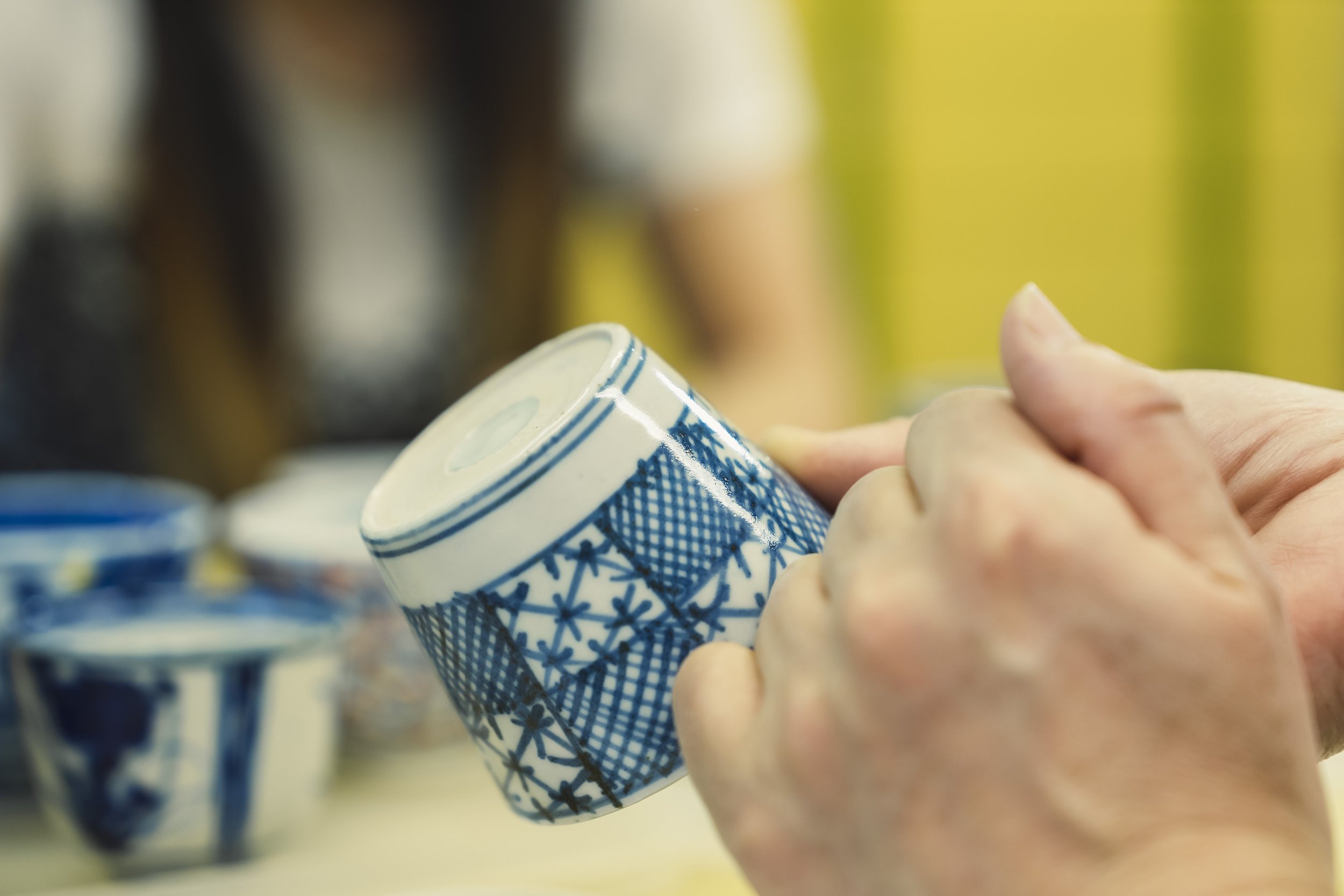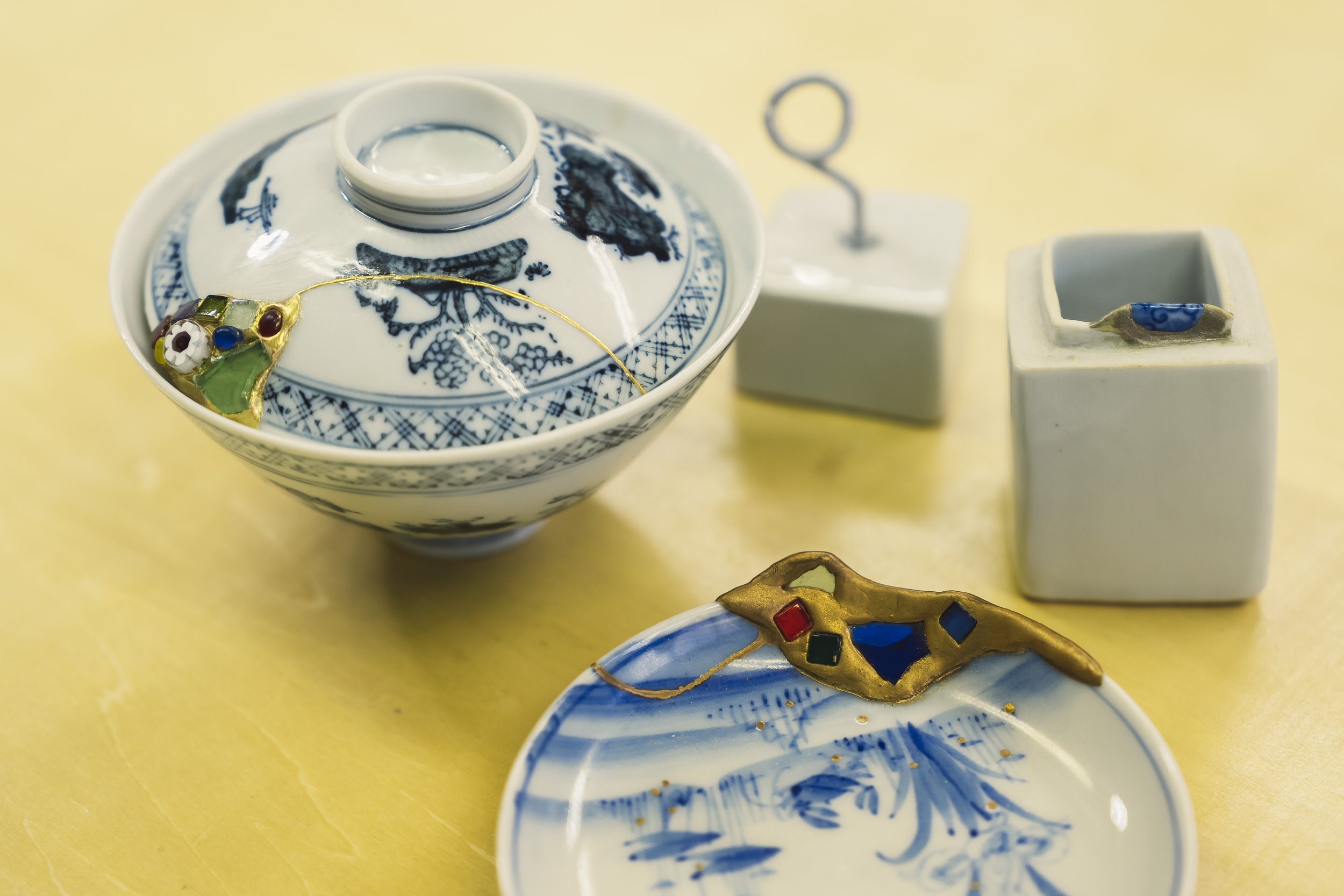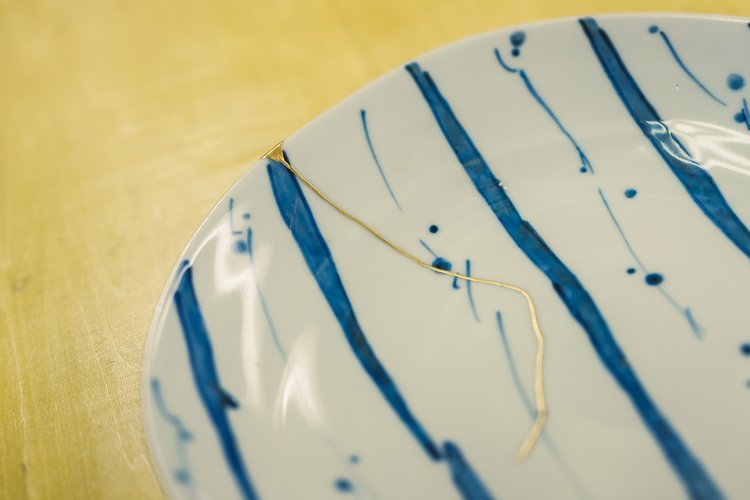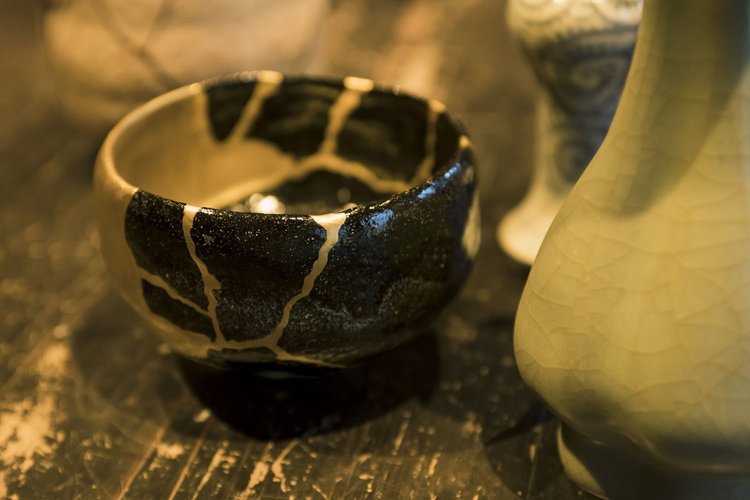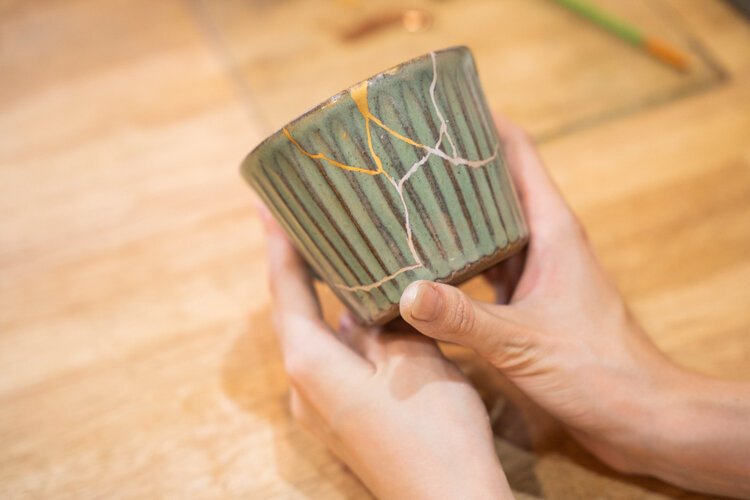Toshie, Kintsugi Master
By Taylor Bond
An artist from birth and a potter by trade, it was a stroke of luck – or fate – that led master craftsperson Toshie to the glittering world of kintsugi.
“At that time, I was working mainly as a pottery teacher. That changed when my sensei needed someone to cover his pottery and kintsugi classes as he underwent surgery.” That was more than 15 years ago. Since then, Toshie has devoted herself diligently to mastering the Japanese art of repair, known for the golden lacquer adorning a restored object. Now, her life gravitates around a schedule of instructing kintsugi lessons, completing orders placed by private customers, and unleashing her creativity on personal projects.
For Toshie, kintsugi was not a craft connected to her family; while many Japanese craftspeople traditionally pass artistic knowledge down by lineage, keeping knowledge contained within the family line, Toshie developed her kintsugi expertise on her own. However, family still played an essential role in fostering her creative instinct. “My mother was a painter and my father was an architect,” Toshie explains, counting off countless other relatives similarly involved in creative fields. She grew up surrounded by artistic passion and maintains that today, even in the most literal sense, operating out of a studio workshop built by her father.
Toshie experiences her kintsugi creativity as an instinct. “I’ll fix the cracks first, but when I’m adding details, I don’t have a plan. I just look at the piece and decide on the spot what is missing and what needs to be added,” she admits, showcasing a bowl for reference. It’s monochromatic, depicting the black shadows of pine trees bending in the wind and birds darting through the branches; the only glimmer of color comes from delicate lines of silver outlining the arch of the branches and bend in the river. That instinct isn’t only limited to her kintsugi work, Toshie explains. “I use the same instinct when I make pottery as well.”
Kintsugi is commonly linked to wabi-sabi, an aesthetic belief derived from Buddhist teachings that appreciates beauty in the “imperfect, the impermanent, and the incomplete,” and mushin, “no-mind,” or, acceptance of changing conditions. Despite her creative flexibility and instinct, Toshie’s initial attraction to kintsugi had nothing to do with philosophical principles or Zen ideals.
Holding up a white plate split evenly down the center and fixed with a sleek line of sealant and dusted gold, Toshie clarifies her fascination with the art: “I was just drawn to the beauty of using gold to repair broken things – it looked beautiful and interesting. I didn’t think of wabi-sabi at all.”
Rather, she points to another Japanese philosophical principle that has more relevance both to her kintsugi practice and to her daily life – that of mottainai. A feeling of regret over needlessly wasting items, which can be applied to objects of all varieties – children’s toys, old clothes, and of course, even pieces of pottery centuries old – mottainai stresses the importance of both conservation and respecting the value of the material. According to Toshie, “It would be a shame to waste something that still has good use. And it’s rewarding to repair something so that it can be useful again.”
She put that perspective into practice following the aftermath of the Tohoku earthquake and tsunami in March 2011. The most powerful earthquake ever recorded in Japan, this disaster caused an estimated $235 billion dollars of economic loss and the irrevocable destruction of vast amounts of public and private property. “Following 3.11, I had a lot of requests to fix pottery damaged in the earthquake – items that were special, that the families wanted to preserve and pass down to future generations.” Thanks to Toshie’s masterful work, countless families were able to conserve the object and associated memories, discovering new life in their treasured works of art.
For Toshie, kintsugi’s capacity to preserve the past extends deeper than merely conserving resources or salvaging objects – it also acts as a way to bond together history with the contemporary. She shows off two cups, both white and blue in color and small enough to fit neatly in her palm, with small chips that have been filled in with gold. Gesturing to one, she proudly says, “this one’s from the early Showa era,”— a historical period that began almost 100 years ago and was characterized by rapid industrialization. The other one, however, Toshie treats with even more reverence. “And this one is from the Edo era,” an era renowned for samurai, geisha, and ukiyo-e art. “I discovered both of them in flea markets and bought them to use in classes.” Toshie has refurbished both relics of history to be actively used in everyday, modern life.
An artistic practice thought to date back to the 14th century, kintsugi’s popularity was closely tied to its usage in sado, or tea ceremony. Undergoing a significant stylistic shift led by Sen no Rikyu, sado and its new focus on humble tea ware and storied objects melded easily with kintsugi, each practice informing the other. Toshie imparts this background for every lesson taught in her workshop, placing additional emphasis on the ways in which the past has shaped the present practice of both sado and kintsugi.
And yet, while dedicated to preserving this centuries-old art, Toshie values innovation as much as she does tradition. She’s unafraid of pruning unnecessary practices and swapping out burdensome tools and materials in order to meet contemporary circumstances.
Take, for example, the material used to bind together the broken pieces of pottery, known as urushi lacquer. Despite the numerous applications of urushi throughout Japanese history, the material possesses several issues. Not only does it contain urushiol, an allergenic compound similarly found in poison ivy that causes itchy rashes, the drying time for urushi is precarious, depending upon carefully balanced humidity levels and taking up to two months to cure. With this in mind, Toshie opts for a combination of epoxy and a cashew nut urushi alternative that can dry within a single day and is more durable than the traditional bonding method.
“Some craftsmen still choose to use entirely traditional methods – urushi sap or pure gold powder. It’s simply a matter of preference,” Toshie explains, as she points out the 80%-brass, 20%-copper mix she utilizes in place of pure gold powder, which achieves a similar, sparkling luster but increases the overall affordability. “For me, it’s a combination of reasons. Urushi has a higher chance of re-breaking after the item has been repaired. Epoxy has a stronger bond and is more suitable for everyday life. It’s also better for teaching classes since it dries faster and makes it more accessible to pass the skill along to the next generation.”
Convenience isn’t the only alteration she’s willing to make when it comes to kintsugi; one of the things that excites her most about the modern usage of kintsugi is its ability to be infused into other artistic practices. “It’s exciting seeing the artistic, unconventional ways kintsugi can be used.” And it is through these evolving, contemporary applications that Toshie foresees the art form continuing to thrive for generations and generations to come.
She grabs one of her own less conventional examples from the wall of displays surrounding the center workshop table – storage cabinets filled with packaged pottery pieces poking out from behind wicker baskets, cylinder containers overflowing with brushes and tools of varying shapes and sizes, and large stacks of books. The retrieved piece refracts a kaleidoscope of colors, which combines the art of kintsugi with the yobitsugi technique.
“When an entire piece of the pottery is missing, you can use yobitsugi to fill in the gap. Instead of just putting the pieces back together, you can improve it and put more originality into the process.” In addition to the real-life example, she also flips open a book, showing a cup – once-shattered, now completely reconstructed using a hodge-podge of different ceramic pieces – coming together seamlessly to recreate the original shape – even if not using the original pieces of the pottery.
Aside from yobitsugi, Toshi also uses kintsugi techniques to infuse additional artist elements onto pre-existing pieces. She recounts fixing an enormous crack in a slab of a stone countertop, and teaching kintsugi techniques to a fellow artist requiring repairs on the severed tail of a horse sculpture.
Another innovative item she showcases is a rice bowl, cracks fixed traditionally. Tucked into the interior of the bowl, nearly hidden from view is an embossed design of overlapping lines etched into the gold. “I had to seal it first with the lacquer. Then, I added extra layers of urushi on the dried layer to create more texture and design.”
More so than in designing or in repairing, however, Toshie believes the most rewarding part of her life as a master kintsugi craftsperson is in watching the look of revenant shock on students’ faces as they handle items made countless centuries ago. In these moments of transmitting knowledge from teacher to student, Toshie can be seen as creating a new kind of "family" lineage, blending tradition and modernity, past and present.
“People get surprised hearing the age of the ceramics being repaired,” she explains with a proud smile, putting the bowl down gently again on her wooden workshop table. “They’re shocked that what they’re touching is so old. And they’re delighted to hold that piece of history in their hands.”
Read more about Toshie’s kintsugi gold repair workshop and experience here.
About the Author: A creative writer and Japanese Literature and Culture scholar, Taylor Bond focuses her academic research on cultural formation, folklore, and East Asian culture. Her creative work includes both prose and poetic content, often exploring themes of the body and lyrical surrealism.


